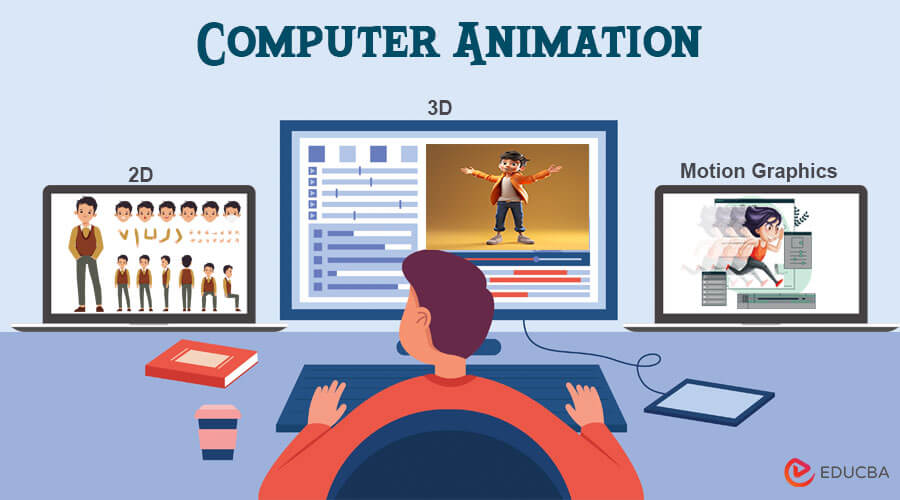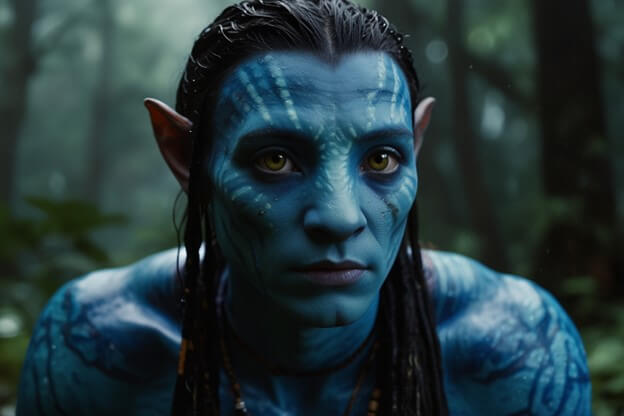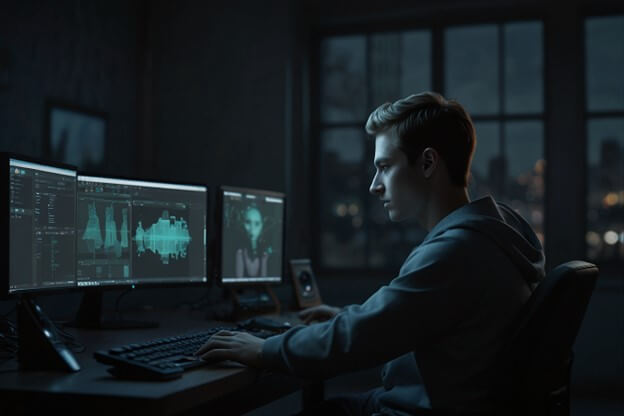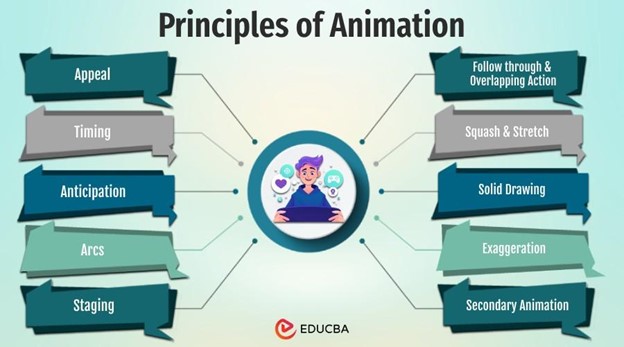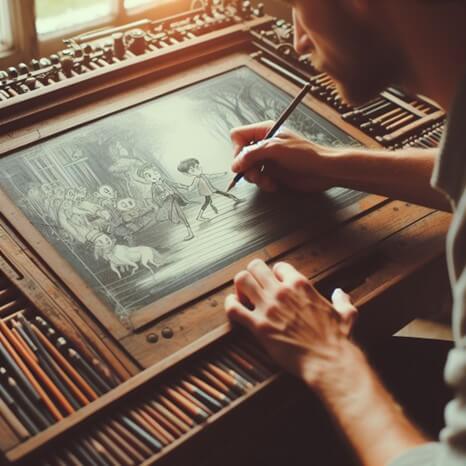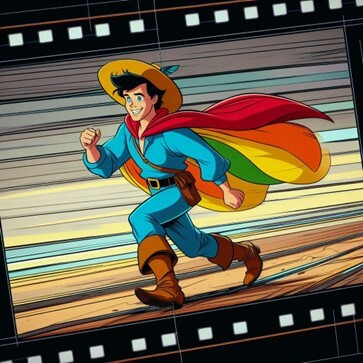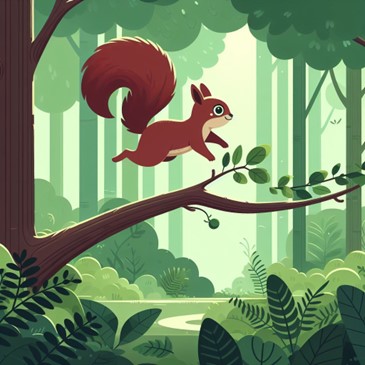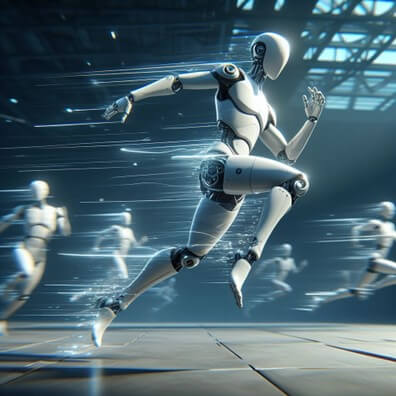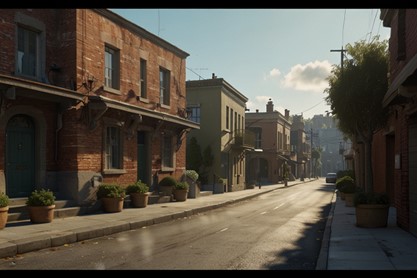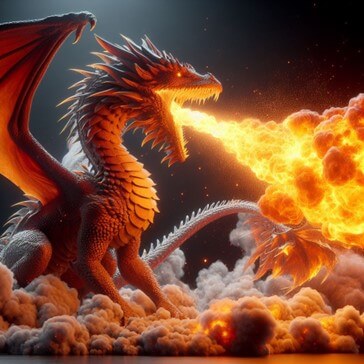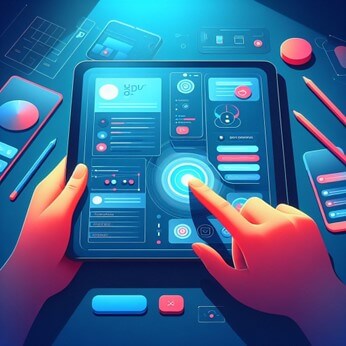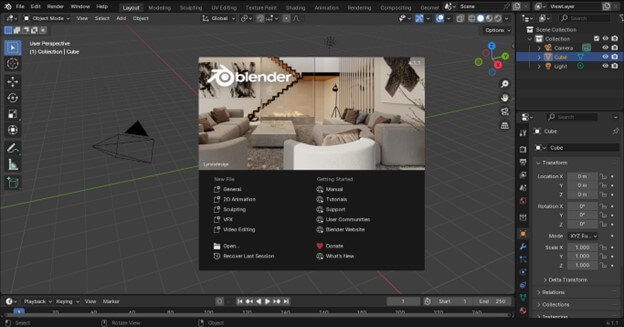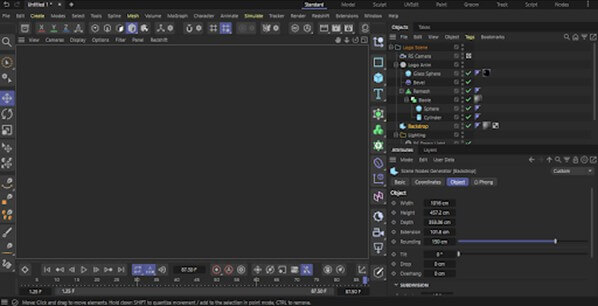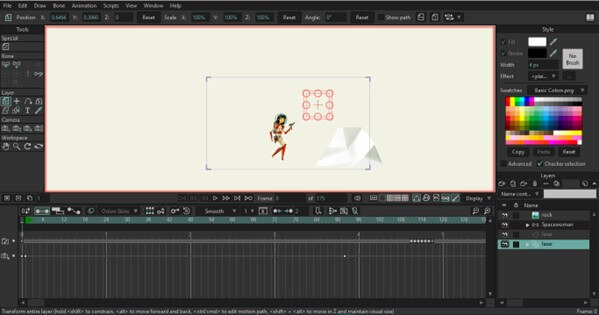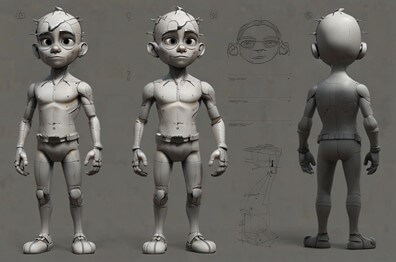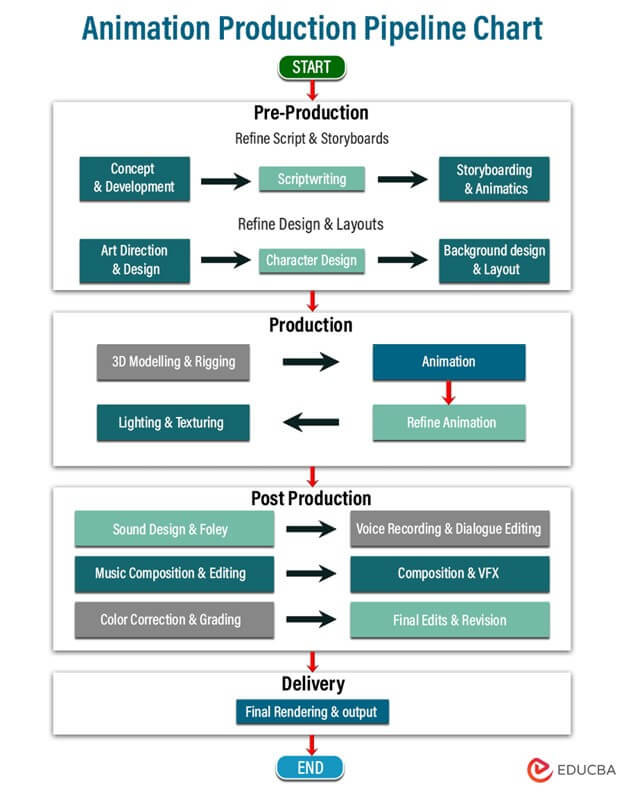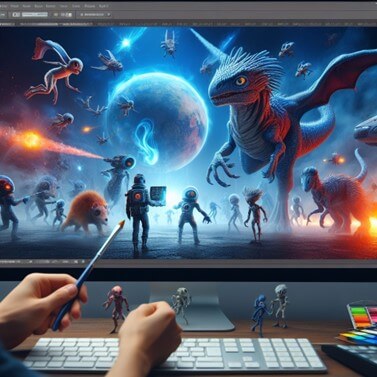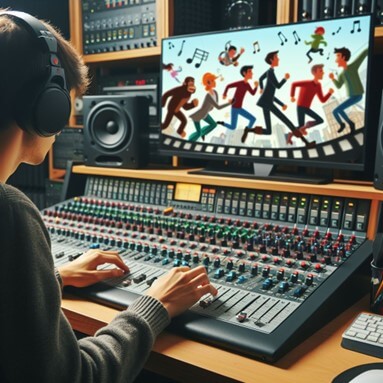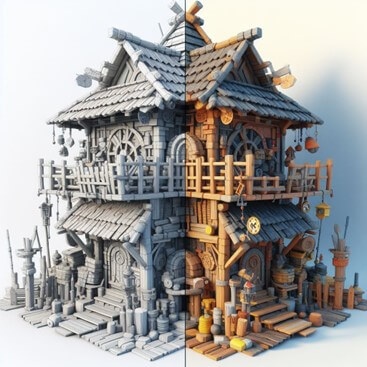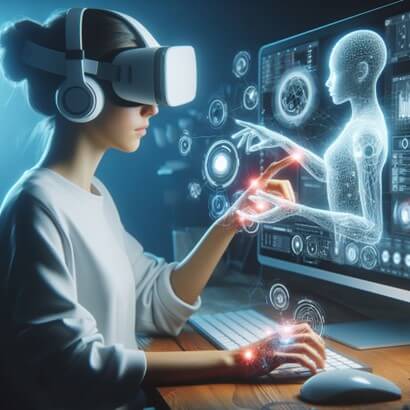Introduction to Computer Animation
At its core, computer animation is the fusion of artistic expression and technological innovation, enabling creators to craft dynamic visual narratives in the digital realm. Unlike traditional animation methods, which rely on manual techniques, computer animation harnesses the power of software and digital tools to sculpt lifelike characters, intricate environments, and captivating stories. This approach offers unparalleled flexibility, allowing animators to explore diverse visual styles and effects precisely and efficiently. From hyper-realistic renderings to whimsical abstractions, computer animation allows artists to explore and expand the limits of creativity and imagination. Its pervasive influence spans industries, captivating audiences in entertainment, conveying messages in advertising, educating learners, and simulating environments for various purposes. As technology advances, the field of computer animation progresses alongside it, promising endless possibilities for innovation and storytelling on a global scale.
Table of Contents
History and Evolution of Computer Animation
Early Beginnings (1950s-1960s)
- Researchers began experimenting with computer-generated imagery (CGI) in the 1950s, tracing the roots of computer animation back to that era.
- In 1958, Ivan Sutherland created the first computer-based graphics program, Sketchpad, which laid the groundwork for future computer and animation developments.
- Throughout the 1960s, pioneers such as John Whitney and Ivan Sutherland continued to explore the possibilities of computer-generated animation, albeit with limited computing power and technology.
Emergence of CGI (1970s-1980s)
- The 1970s saw significant advancements in computer technology, paving the way for the emergence of computer-generated imagery (CGI) in films and television.
- In 1972, Ed Catmull and Fred Parke developed the first computer-generated 3D animation of a human face, marking a significant milestone in the history of computer animation.
- In 1977, the film Star Wars revolutionized visual effects by introducing computer-generated imagery, showcasing the potential of CGI in filmmaking.
- Throughout the 1980s, companies like Pixar, founded by Ed Catmull and Alvy Ray Smith, and Industrial Light & Magic (ILM) pushed the boundaries of computer animation with groundbreaking films like Toy Story and The Abyss.
Rise of CGI in Film (1990s-2000s)
- The 1990s witnessed a surge in the use of CGI in film and television, with advancements in rendering technology and increased computing power.
- Pixar’s Toy Story (1995) became the first feature-length film entirely created with CGI, setting a new standard for animated filmmaking.
- Other studios, such as DreamWorks Animation and Blue Sky Studios, also entered the market, producing successful CGI films like Shrek and Ice Age.
- Further advancements in CGI technology occurred in the 2000s, with films like Avatar (2009) pushing the boundaries of visual effects and immersive storytelling.
Expansion into Other Industries (2010-present)
- Computer animation has recently expanded beyond the film industry into video games, advertising, and virtual and augmented reality.
- Real-time rendering technology has become increasingly prevalent, enabling interactive experiences and immersive storytelling in video games and virtual environments.
- Advances in motion capture technology have facilitated more realistic character animation, blurring the lines between live-action and CGI.
Principles of Animation
| Principle | Description |
| Timing | It sets the pace and cadence of motion, which is pivotal for expressing weight, emotion, and authenticity. |
| Squash & Stretch | Distorts the form of objects in motion to communicate weight and suppleness, which is crucial for crafting fluid and dynamic animations. |
| Anticipation | Anticipates forthcoming actions by signaling movements in advance, enhancing animations’ credibility and organic feel. |
| Follow Through and Overlapping Action | Adds secondary motion to primary movements, mimicking the natural physics of movement and increasing realism; includes follow-through (continuation of motion after the main action) and overlapping action (different parts of an object moving at different rates). |
| Arcs | Objects follow curved paths during movement, and smooth arcs create natural and pleasing animations that guide the viewer’s eye and convey trajectory. |
| Staging | Clears the path for animations to unfold in a visually captivating way, steering viewer focus and expressing mood or emotion via composition, framing, and camera angles. |
| Exaggeration | Emphasizes and amplifies characters’ actions and expressions for added engagement and entertainment while maintaining realism; exaggeration helps convey emotions and messages effectively. |
| Solid Drawing | Utilizes traditional drawing principles to fashion credible three-dimensional objects and characters in animation; comprehending form, anatomy, and perspective is imperative for crafting convincing animations. |
| Appeal | Ensures characters and animations are visually attractive and charismatic to the audience, enhancing engagement and relatability; appealing characters captivate viewers’ attention and foster emotional connections. |
| Secondary Animation | Introduces supplementary motion to objects or characters, such as hair, attire, or accessories responding to primary movement; amplifies realism and visual allure by injecting layers and intricacies into animations. |
Types of Computer Animation
2D Animation
- Traditional Hand-Drawn Animation:
Traditional hand-drawn animation entails crafting every frame manually, often on paper or digital drawing tablets. Animators sketch pivotal poses known as “keyframes” and then interpolate “in-between frames” to achieve seamless motion. This method boasts a rich heritage in animation and remains prevalent in both indie and commercial productions.
- Digital Cel Animation:
Digital cel animation, also termed raster-based animation, emulates the aesthetic of traditional cel animation using digital techniques. It involves generating characters and backgrounds as distinct layers, enabling animators to animate them autonomously for intricate movements and effects. Widely employed in TV shows, web series, and short films, digital cel animation offers versatility and efficiency.
- Vector-Based Animation: Vector-based animation utilizes mathematical equations to produce images and animations rooted in geometric shapes, lines, and curves. Unlike pixel-dependent raster animation, vector animation maintains resolution independence, facilitating seamless scaling without losing quality. Flash animation, a prevalent vector-based animation, is widely used in web animations and interactive media.
3D Animation
- Character Animation: Character animation breathes life into three-dimensional characters through their movements and expressions. Animators utilize advanced rigging and skeletal systems to govern the motion of characters’ limbs, facial features, and bodies. Motion capture technology, which captures actors’ movements and translates them to digital characters, is frequently employed to craft realistic and nuanced animations for films and video games.
- Environmental Animation: Environmental animation focuses on bringing three-dimensional landscapes, buildings, and natural elements to life. Animators employ particle systems, dynamic simulations, and procedural generation techniques to craft immersive and authentic virtual worlds. This type of animation finds applications in animated films, video games, virtual reality experiences, and architectural visualization.
- Visual Effects (VFX): Visual effects animation seamlessly blends computer-generated imagery (CGI) with live-action footage to produce breathtaking and unbelievable visual effects. VFX animators employ compositing, rotoscoping, and match-moving techniques to merge CGI elements with real-world settings and characters. VFX animation enhances storytelling and creates captivating action sequences widely utilized in blockbuster films, television shows, and advertisements.
Motion Graphics
- Typography Animation: Animation animates text and typographic elements to convey information, evoke emotions, and enrich visual storytelling. Animators employ kinetic typography, text effects, and typographic animation presets to infuse dynamism into static text. This form of animation finds widespread application in title sequences, advertisements, explainer videos, and multimedia presentations.
- Data Visualization: Data visualization animation brings data-driven graphics, charts, and infographics to life, elucidating intricate concepts, trends, and statistics. Utilizing motion graphics software and scripting languages, animators craft dynamic and interactive visualizations that captivate and enlighten viewers. This type of animation serves various purposes, including educational videos, news broadcasts, business presentations, and scientific research.
- UI/UX Animation: UI/UX animation animates user interface (UI) elements and interactive components to enhance user experience (UX) and usability. Employing motion design principles, animators create seamless transitions, micro-interactions, and feedback animations that facilitate user navigation and augment usability. UI/UX animation is integral to mobile apps, websites, software interfaces, and interactive prototypes.
Software and Tools for Computer Animation
2D Animation Software
- Adobe Animate (formerly Flash): Renowned for its versatility, Adobe Animate is a software solution for crafting interactive animations, web-based cartoons, and vector-based animations. Its toolkit encompasses features for both traditional frame-by-frame animation and puppet-based animation.
- Toon Boom Harmony: Toon Boom Harmony is a professional-grade software meticulously crafted for traditional and digital 2D animation. It boasts a plethora of advanced tools catering to rigging, compositing, and special effects, rendering it a preferred choice among seasoned animators and studios.
- TVPaint Animation: TVPaint Animation garners recognition for its robust suite of drawing and painting tools, making it a prime option for traditional hand-drawn animation endeavors. Its repertoire includes diverse features tailored to crafting expressive and fluid animations. This evolution solidifies computer animation as a fundamental preferred option among professionals in the film and television sectors.
3D Animation Software
- Autodesk Maya: Autodesk Maya is a comprehensive 3D animation software for modeling, rigging, animation, and rendering. The film, television, and video game industries widely adopt it for its powerful features and flexibility.
- Blender: Blender stands out as a free and open-source 3D creation suite. It includes modeling, rigging, animation, simulation, rendering, compositing, and motion tracking features. A vibrant community uses it for various animation projects, from indie films to video games.
- Cinema 4D: Its intuitive interface and robust tools make Cinema 4D a user-friendly option for 3D animation software, earning it renown. It is popular among motion graphics artists, designers, and visual effects professionals for its ease of use and versatility.
Motion Graphics and Visual Effects (VFX) Software
- Adobe After Effects: Recognized as a premier software for crafting motion graphics, visual effects, and compositing, Adobe After Effects provides an extensive array of tools that empower users to animate text and graphics, apply special effects, and seamlessly integrate 2D and 3D elements into video projects.
- Blackmagic Fusion: Blackmagic Fusion is a professional-grade compositing software indispensable for generating visual effects and motion graphics. Its node-based interface facilitates compositing, keying, tracking, and 3D animation, making it a formidable asset for VFX artists and filmmakers.
- Nuke: Nuke has established itself as the industry standard in compositing software, revered for crafting top-tier visual effects for film and television. Boasting a node-based workflow, it enables seamless integration of CGI with live-action footage alongside functionalities for compositing, 3D tracking, and color grading, elevating the creative process for artists.
Specialized Animation Tools
- Dragonframe: Regarded as the premier software for stop-motion animation, Dragonframe facilitates the capturing and editing of stop-motion sequences. Equipped with features like onion skinning, time-lapse photography, and camera control, it caters specifically to the needs of stop-motion animators.
- Moho (formerly Anime Studio): Moho, formerly known as Anime Studio, is a specialized 2D animation software focusing on rigging and character animation. Its bone-based rigging tools and automatic lip-syncing features make it adept at creating animated characters tailored for cartoons, web series, and explainer videos.
Creation in Computer Animation
Character Design and Development
Character design and development involve conceptualizing and creating animated characters’ visual appearance, personality, and traits. This process often starts with sketches, concept art, and 2D or 3D software and then is translated into digital models. In order to give characters life, make them aesthetically pleasing, and establish a connection with the viewer, character designers concentrate on shape, color, anatomy, and expression.
Animation production pipeline
The animation production pipeline encompasses the stages and processes of creating an animated project, from the initial concept to the final output. This production typically includes pre-production, production, and post-production phases. Key steps in the pipeline include storyboarding, layout, modeling, rigging, animation, lighting, texturing, rendering, and compositing. Each stage involves collaboration between different departments and artists to ensure the project progresses smoothly and meets the creative vision.
Special Effects and Visual Enhancements
Special effects (FX) and visual enhancements enrich computer animation’s visual appeal and impact. These enhancements incorporate particle effects, simulated physics, fluid dynamics, and environmental effects such as smoke, fire, water, and explosions. Additionally, visual enhancements encompass techniques like color grading, depth of field, motion blur, and post-processing effects, all of which aim to elevate the overall appearance and atmosphere of the animation.
Sound Design and Integration
Sound design and integration encompass the creation and inclusion of audio components into the animation, aiming to enrich storytelling, evoke emotions, and immerse the audience in the animation’s world. This process involves recording dialogue, sound effects, and music and editing, mixing, and synchronizing the audio with the visuals. Sound designers collaborate closely with animators and directors to ensure that the audio aligns with and amplifies the narrative and emotional resonance of the animation.
Rendering and Output
Rendering encompasses creating the ultimate images or frames of the animation from 3D scene data. This rendering entails computations for lighting, shading, textures, and camera angles to craft realistic and aesthetically pleasing visuals. Rendering can be executed through CPU-based or GPU-based rendering engines, offering choices between offline and real-time rendering. Subsequently, diverse distribution formats deliver the finalized animation, including digital files suitable for streaming, broadcast, or projection.
Trends and Innovations in Computer Animation
AI and Machine Learning in Animation
- Automation of Repetitive Tasks: AI and machine learning technologies are revolutionizing animation production by automating repetitive tasks. For instance, character rigging, which involves creating a skeleton for characters to enable movement, can be automated using AI algorithms. Similarly, motion capture, the process of recording and translating human movements into digital characters, can benefit from AI-driven motion tracking systems that streamline the animation process.
- Enhanced Animation Quality: Machine learning techniques are employed to analyze and predict animation trends, allowing animators to stay ahead of industry developments and create content that resonates with audiences. Furthermore, machine learning algorithms can analyze extensive datasets of motion capture data, discerning patterns and enhancing the authenticity of character movements.
- Realistic Movements and Expressions: AI and machine learning algorithms can generate realistic movements and expressions for characters by analyzing motion capture data and identifying subtle nuances in human movement. These algorithms allow animators to produce animations that exhibit greater realism, connecting with audiences on an emotional level.
Virtual Reality(VR) and Augmented Reality(AR) in Animation
- Immersive Storytelling: Virtual reality (VR) technology allows viewers to immerse themselves in virtual worlds and experience animations from a first-person perspective. This immersive storytelling enhances viewer engagement and creates more memorable and impactful experiences.
- Interactive Experiences: Augmented reality (AR) overlays digital animations onto the real world, blurring the lines between physical and virtual environments. This interactive animation approach enables viewers to engage with animated characters and objects within their real-world environment, fostering distinctive and personalized experiences.
- Applications Across Industries: Animation studios are exploring VR and AR applications across various industries, including entertainment, education, training, and marketing. For example, Training in healthcare and aviation industries uses VR simulations. At the same time, AR experiences can enhance educational content by bringing concepts to life in a tangible way.
- Innovative Storytelling: VR and AR technologies offer animation studios new opportunities for creative storytelling techniques. For example, VR storytelling allows creators to transport viewers to fantastical worlds and immerse them in captivating narratives. In contrast, AR storytelling can enhance real-world experiences with digital overlays and interactive elements.
Future Career in Computer Animation
Career Paths in Computer Animation:
The field of computer animation offers diverse career paths, including:
- Animator: Animators create movement and bring characters, objects, and environments to life using 2D or 3D animation techniques.
- Modeler: Modelers create digital models of characters, props, and environments using specialized software. They focus on sculpting, texturing, and detailing digital assets to meet the artistic vision of a project.
- Rigging Artist: Rigging artists build skeletal systems for characters and objects, allowing them to move and deform realistically during animation.
- Lighting and Rendering Artist: Lighting and rendering artists are responsible for setting up and adjusting lighting, shading, and rendering settings to achieve a scene’s desired look and feel.
Future Trends in Computer Animation:
Key trends shaping the future of animation include:
- Real-time Animation: Advances in real-time rendering technology enable animators to create high-quality animations in real time, reducing production time and costs.
- Virtual Production: Virtual production techniques, such as using LED screens and virtual sets, revolutionize how filmmakers and television producers produce their shows, providing new opportunities for animators to collaborate with filmmakers and create immersive visual experiences.
- AI-Driven Animation Tools: Automating tasks and enhancing workflow efficiency.
Skills and Qualifications:
- Required skills include proficiency in animation software, understanding of animation principles, and knowledge of 3D modeling and rendering techniques.
- A degree or certificate in animation or related fields is beneficial, but a strong portfolio is equally important.
Career Development and Growth:
- Professionals must stay updated with industry developments through continuing education and networking.
- Career growth opportunities include advancing to managerial roles, specializing in specific animation areas, or transitioning into related fields like game development or virtual reality.
Conclusion
The field of computer animation presents a dynamic and promising landscape for creative professionals. With advancements in technology, such as AI-driven tools and real-time rendering, and emerging trends like virtual production, exciting possibilities fill the future of animation. Aspiring animators can embark on diverse career paths, from character animation to visual effects, andTo remain competitive, they must always improve their abilities. An individual can succeed in this constantly changing field if they are dedicated, creative, and have a lifelong learning commitment. This field contributes to developing immersive and captivating animated experiences for audiences globally.
Frequently Asked Questions (FAQs)
Q1. What are some common challenges in computer animation?
Answer: In computer animation, common hurdles include attaining lifelike movement and expressions, navigating intricate projects under strict timelines, ensuring coherence across various software and hardware systems, and keeping abreast of dynamic technological advancements and industry shifts.
Q2. How important is storytelling in computer animation?
Answer: Effective storytelling is vital in computer animation for engaging audiences, eliciting emotions, and conveying messages successfully. When a compelling narrative intertwines with well-crafted characters, immersive settings, and captivating visuals, it has the power to captivate viewers, leaving a lasting impression and making the animation more impactful.
Q3. How does technology impact computer animation?
Answer: Technology advancements enhance computer animation by offering new tools, techniques, and possibilities. Improved hardware and software capabilities enable animators to create more complex and realistic animations efficiently.
Recommended Articles
We hope that this EDUCBA information on “Computer Animation” was beneficial to you. You can view EDUCBA’s recommended articles for more information,
